BEST
FRIENDS ANIMAL SANCTUARY
Kanab,
Utah
June
24–28, 2007
ON THE BUMPY ROAD TO KANAB
Our purpose for this trip was to volunteer at Best Friends Animal Sanctuary
in Kanab, Utah. To get there, we traveled west on I-70 to Colorado 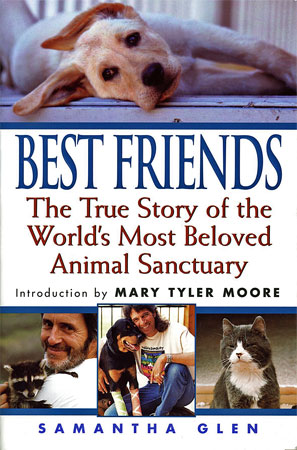 National Monument near Grand Junction, on to Green River,
Utah, and then south to Capitol Reef National Park, west to Richfield
and then south to Kanab. We endured some ferocious heat (upper 90s and
low 100s); our “house” batteries failed, but we swapped them out for
new ones under warranty in Grand Junction; most inconvenient was our
engine going into the infamous “limp home mode” due to a turbo
resonator failure, a defect well known among owners of Itasca and
Winnebago RVs powered by Dodge Sprinters (though it’s hard to find any
Dodge dealer who’s ever heard of this happening!) We had to cancel our
reservations at Kodachrome Basin State Park and endure a 200-mile tow
from Richfield to Ogden for repairs. In spite of all, we made it to
Kanab on time.
National Monument near Grand Junction, on to Green River,
Utah, and then south to Capitol Reef National Park, west to Richfield
and then south to Kanab. We endured some ferocious heat (upper 90s and
low 100s); our “house” batteries failed, but we swapped them out for
new ones under warranty in Grand Junction; most inconvenient was our
engine going into the infamous “limp home mode” due to a turbo
resonator failure, a defect well known among owners of Itasca and
Winnebago RVs powered by Dodge Sprinters (though it’s hard to find any
Dodge dealer who’s ever heard of this happening!) We had to cancel our
reservations at Kodachrome Basin State Park and endure a 200-mile tow
from Richfield to Ogden for repairs. In spite of all, we made it to
Kanab on time.
BEST FRIENDS ANIMAL SANCTUARY
The story of Best Friends is a good one. In 1982, a
group of friends dedicated to rescuing animals, purchased about 3,000
acres of land along Kanab Creek five miles north and west of Kanab,
Utah. The ranch was for many years the location for numerous westerns
and TV programs filmed in this scenic valley. They worked to build a
no-kill animal sanctuary that would offer lifetime care and shelter to
nearly 2,000 animals that were strays or abandoned, found injured, left
behind when an owner died, victims of fire, hurricanes, war, or were
simply unable to be cared for by their owners. Today, supported by
donations of money, resources, and time by many thousands of
individuals and groups, Best Friends has become the nation’s—perhaps
the world’s—largest no-kill sanctuary. It also provides a resting place
for those animals who, either in the care of Best Friends or pets whose
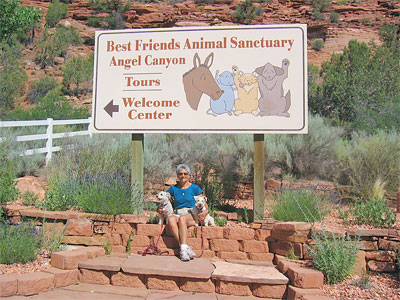 owners
come from all over the country, have “crossed over the Rainbow
Bridge” and are buried or memorialized at the Sanctuary’s “Angels
Rest.” The story of how Best Friends was founded and has prospered can
be found in Samantha Glen’s very readable and inspiring Best
Friends: The True Story of the World’s Most Beloved Animal Sanctuary
(Kensington Books, 2001). If you read it, you’ll want to join us in
becoming contributing members.
owners
come from all over the country, have “crossed over the Rainbow
Bridge” and are buried or memorialized at the Sanctuary’s “Angels
Rest.” The story of how Best Friends was founded and has prospered can
be found in Samantha Glen’s very readable and inspiring Best
Friends: The True Story of the World’s Most Beloved Animal Sanctuary
(Kensington Books, 2001). If you read it, you’ll want to join us in
becoming contributing members.
Though we have been members of Best Friends for many
years, we did not visit the sanctuary until 2000 when we stayed several
nights in one of the few cabins on the property and took the tour and
hiked the property. We were impressed and vowed to return as
volunteers. Four years later, granddaughter Julia spent a week of her
summer vacation with Judy volunteering at Best Friends. For both of
them, the week was memorable.
This was the summer we decided to return together.
BRIEF NOTE ABOUT KANAB
Kanab
is in southern Utah, three miles from the Arizona border, surrounded by
Grand Canyon, Zion and Bryce National Parks, and is memorable for the
red sandstone formations found throughout the southwest. Early attempts
of settlement by Mormons in the mid-19th century were contentious
(after all, several Native American groups were living nearby and had
prior claims to the area), but after three attempts a small group laid
out a typical Mormon community of wide streets in 1870. Residents
quietly farmed wheat and raised cattle for several generations. The
area began to boom in the 1920s when Tom Mix filmed a movie near here
and Hollywood folks became a 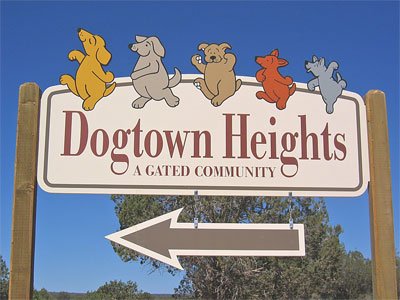 presence for the next half-century. Angel Canyon, five
miles north of town, was often used as a movie location, but by the
1950s reverted to cattle ranching land until purchased by Best Friends.
presence for the next half-century. Angel Canyon, five
miles north of town, was often used as a movie location, but by the
1950s reverted to cattle ranching land until purchased by Best Friends.
WORKING
WITH THE DOGS AND BIRDS
We checked in at the Best Friends Welcome Center,
got directions to their new “campground” and met with the volunteer
coordinator for our assignments. We drove to the campsite, set up our
RV one of the two sites with full hookups (but no bathroom or shower
facilities!), plugged in the electricity and turned on the A/C to keep
Bella and Sophie cool. We biked five miles to Dogtown Heights, a “Gated
Community” according to the entrance sign. (There is a beautiful
metal sculpted gate across the road at the entrance.) We met with Bryan
Chesser who was by himself this afternoon in charge of the two pods/ten
kennels/about 30 dogs that comprise “The Club House.” He was glad for
the help and allowed that we were just in time to scoop plenty of poop
and prepare the afternoon meals. After the dogs were fed, we swept and
mopped the kennels and common rooms in preparation for afternoon tours.
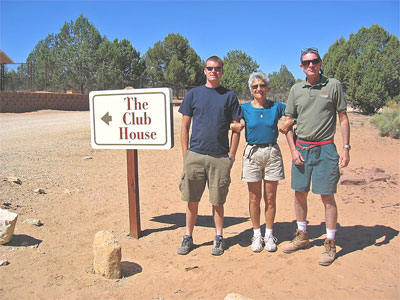 After work, we stopped by the bird area where Hughes was assigned for
the next two days. They were temporarily shorthanded at the bird
facility (“Feathered Friends”) because of several regular staff
illnesses and days off. Ken Theus was glad to see him. Ken was very
easy to work with and very knowledgeable. He even volunteered to pick
Hughes up in the morning and bring him back in the afternoon. He said
we would work from 8:00–5:00, so Judy, who would work a 9:00–3:00 shift
with the dogs, would “commute” to work by bike.
After work, we stopped by the bird area where Hughes was assigned for
the next two days. They were temporarily shorthanded at the bird
facility (“Feathered Friends”) because of several regular staff
illnesses and days off. Ken Theus was glad to see him. Ken was very
easy to work with and very knowledgeable. He even volunteered to pick
Hughes up in the morning and bring him back in the afternoon. He said
we would work from 8:00–5:00, so Judy, who would work a 9:00–3:00 shift
with the dogs, would “commute” to work by bike.
For the next two days Judy worked for Bryan (on the
left) and Jose Pico: she walked dogs all morning while Hughes was
cleaning the indoor bird cages (changed newspaper, mopped the bird poop
off the floors and walls) as the birds were moved to their outdoor
cages. We met for lunch at the cafeteria at Angel Village, a beautiful
facility with floor to ceiling windows and an outdoor eating area that
sits high above the canyon with sweeping views in both directions (in
photo below on the rim overlooking the horse field). Four dollars paid
for a scrumptious buffet (vegetarian, of course).
The afternoon routines at Dogtown were the same:
scoop poop, prepare the afternoon meals, and clean the kennels.
Meanwhile, at Feathered Friends, the afternoon was time for food
preparation (cracking nuts, filling water and food dishes for each
cage, etc.), and cleaning the cockatoo cages that were housed in a
separate building, away from the parrots, macaws, cockatiels, and
lorikeets. The cockatoos are striking and noisy birds which are kept
separate from the others because they give off more dander, which is a
health hazard to some of the other birds. Who knew?? The afternoon
routines varied a little for two days: Hughes cleaned the pens that 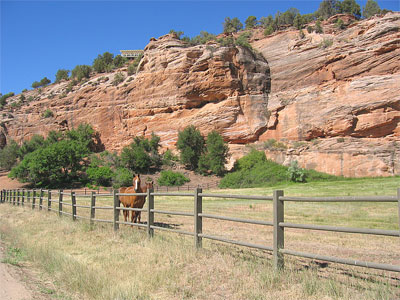 housed the peacocks and peahens, geese, ducks, and pigeons.
Each day he gave the outside birds a shower with the hose to cool them
off. Like the other animal facilities, the focus is on feeding the
birds and keeping their living conditions healthy and clean. Everyday.
There are no days off at Best Friends.
housed the peacocks and peahens, geese, ducks, and pigeons.
Each day he gave the outside birds a shower with the hose to cool them
off. Like the other animal facilities, the focus is on feeding the
birds and keeping their living conditions healthy and clean. Everyday.
There are no days off at Best Friends.
We worked together the last two days in Dogtown,
taking the dogs for walks (socializing them helps prepare them for
adoption), feeding, cleaning, poop scooping, etc. The work is not
particularly difficult, certainly not romantic, but absolutely
necessary for the health and well being of the animals. The dogs—and
surely the horses, donkeys, cats, and bunnies as well—crave human
contact, especially 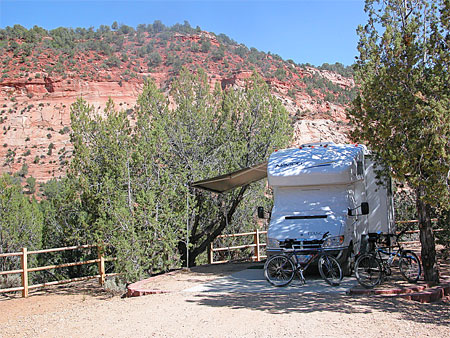 from
people who are caring and friendly. The goal is to heal those animals
who are hurting and, whenever possible, prepare them for adoption. It
may be true for the birds as well, though it’s more difficult to gauge
their responses to human contact. In the process of providing for their
daily needs—food and water, clean conditions, etc.—each person who
comes in contact with them helps to make their re-entry into human
society more acceptable and likely to succeed. It’s true that some
animals, because of physical issues, will live out their natural lives
at Best Friends. However, most are ultimately adopted out to caring
individuals and families.
from
people who are caring and friendly. The goal is to heal those animals
who are hurting and, whenever possible, prepare them for adoption. It
may be true for the birds as well, though it’s more difficult to gauge
their responses to human contact. In the process of providing for their
daily needs—food and water, clean conditions, etc.—each person who
comes in contact with them helps to make their re-entry into human
society more acceptable and likely to succeed. It’s true that some
animals, because of physical issues, will live out their natural lives
at Best Friends. However, most are ultimately adopted out to caring
individuals and families.
THE REST
OF THE TIME
Judy ran most mornings, the coolest part of the day
before the weather turned beastly hot. At the end of each day, we found
we were pretty tired—too tired to bike into town for dinner, which we
had intended to do every evening. Instead, we walked and fed Sophie and
Bella, had gin and tonics in the shade of the cypress and junipers
around our campsite, and when the sun went down we explored our end of
Angel’s Canyon: there were caves, pictographs, and old trails to poke 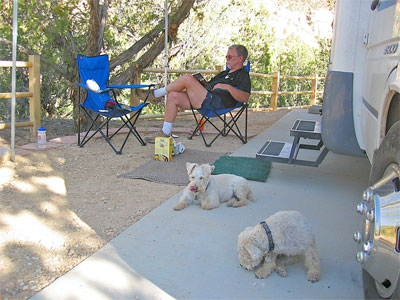 around in. The really nice thing about where we camped was
that the dogs could run free—and they did! Each evening they’d wind up
with red “stains” on their legs from the fine red dust.
around in. The really nice thing about where we camped was
that the dogs could run free—and they did! Each evening they’d wind up
with red “stains” on their legs from the fine red dust.
When it was really hot, we stayed inside and read,
played gin rummy, and kept our travel journal up to date. Thank
goodness for the shower and warm water in the RV. We slept well (and
clean) each night and got up ready to take on another day with the
animals. Sophie and Bella were terrific travel companions: they snoozed
in the air conditioned RV while outside the temperature hit 100+ and in
the evening they had a full-time job of chasing the bunnies out of the
brush around the campground. They slept well at night also.
On our last day, we returned home to find the
campground full! A small Roadtrek had pulled in to othe other site and
the owners had walked the mile to the Welcome Center to take the tour.
The was no noise coming from the vehicle. You can imagine our surprise
when they came back and unloaded three bassets and an English spaniel
from their camper. The dogs had made no noise, and we never heard their
A/C running. When we commented on the “large group” living in the
vehicle, the couple assured us that they and the four dogs were quite
comfortable, and had been over the course of their 6-week road trip.
We attended a monthly “blessing ceremony” at Angels
Rest. This is a spiritual occasion for 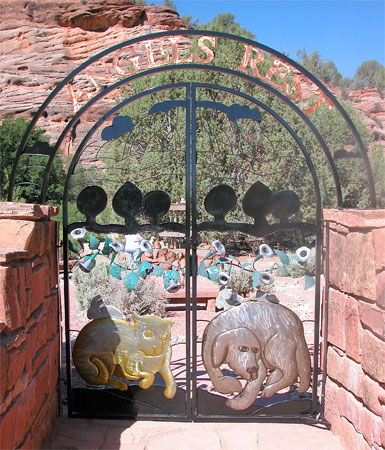 remembering
animals that had recently died. Many in attendance worked there. Anyone
present could offer a tribute to a pet that had passed away some time
ago, as was the case with Judy publicly talked about Gordie who had
died in 2000. We had a wind chime hung on a wind chime tree at the
park. Dan and Debra’s Isis has a wind chime hung there in her honor as
well. The blessing ceremony lasted only a half hour but was moving for
all present.
remembering
animals that had recently died. Many in attendance worked there. Anyone
present could offer a tribute to a pet that had passed away some time
ago, as was the case with Judy publicly talked about Gordie who had
died in 2000. We had a wind chime hung on a wind chime tree at the
park. Dan and Debra’s Isis has a wind chime hung there in her honor as
well. The blessing ceremony lasted only a half hour but was moving for
all present.
LEAVING
BEST FRIENDS
On our last day there, we drove to Angels Rest one
last time to see Gordie’s chime and to take more photos. While we were
there, a stray dog brought to Best Friends from Los Angeles just a few
weeks ago had died the night before and was being buried that morning.
As we did with Gordie’s body when he died suddenly in our backyard, the
Best Friends staff wrapped the dog’s body in a favorite blanket and
buried the body deep in the ground.
We also returned to the bird and dog areas to take
final pictures and say good-bye to those we worked with and to see if
we could get together with some of them for a good-bye dinner.
That afternoon, we left the Best Friends campground
and relocated to the Kanab RV
Corral in town, one of the cleanest RV parks n our trip, where they
have a swimming pool and laundry, as well as flush toilets and showers.
We swam, ran three loads of dirties, and showered. There 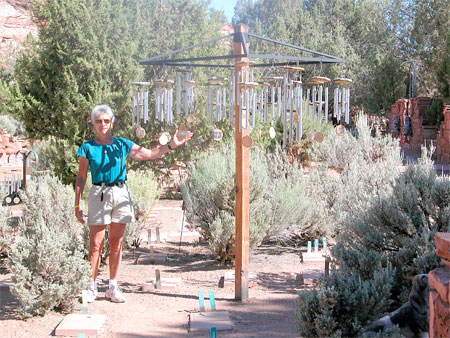 was red dust and sand on everything and it took time to get
all off. In the evening, we shared dinner in town with Jose, Chris, a
precinct captain for the New York City Police Department we’d made
friends with, and Diane, another staff member of Best Friends. (Hughes
also worked with a San Francisco plastic surgeon who had volunteered
with the birds. You can never tell about what kind of folks offer their
time and services at Best Friends!) We had a great farewell dinner at
the Rocking V Cafe, as good
a place to eat anywhere in southern Utah—in fact, anywhere. (Yes, you can get a decent margarita, cold
beer, and a good wine in Utah).
was red dust and sand on everything and it took time to get
all off. In the evening, we shared dinner in town with Jose, Chris, a
precinct captain for the New York City Police Department we’d made
friends with, and Diane, another staff member of Best Friends. (Hughes
also worked with a San Francisco plastic surgeon who had volunteered
with the birds. You can never tell about what kind of folks offer their
time and services at Best Friends!) We had a great farewell dinner at
the Rocking V Cafe, as good
a place to eat anywhere in southern Utah—in fact, anywhere. (Yes, you can get a decent margarita, cold
beer, and a good wine in Utah).
This was Judy’s third trip to the Sanctuary, and
each visit renews her commitment to the efforts of the Best Friends. We
contribute financial support each year, but giving of our time directly
to the animals is more rewarding and gratifying. We should have taken
more photos of the animals we worked with: it will be hard to remember
all the dogs and their stories. If we could have, we would have taken a
dog home every night for a sleep over; Jose takes a different dog each
night since he lost his own dog recently. The sleep overs have to be a
very special treat for the dogs (and cats).
We will go back again and we’ll try to persuade some
of you to join us or go on your own. There are still hikes along Kanab
Creek and places to explore on the property: Hidden Lake, secret side
canyons, and pictographs, caves, and other signs of Anasazi, Fremont,
and Piute peoples who lived there before the Mormons settled in. If you
have any interest at all in being a volunteer at Best Friends, please
contact us for more information and encouragement. After our experience
this summer, however, we think April or May, or October might be a
better time to go.

 National Monument near Grand Junction, on to Green River,
Utah, and then south to Capitol Reef National Park, west to Richfield
and then south to Kanab. We endured some ferocious heat (upper 90s and
low 100s); our “house” batteries failed, but we swapped them out for
new ones under warranty in Grand Junction; most inconvenient was our
engine going into the infamous “limp home mode” due to a turbo
resonator failure, a defect well known among owners of Itasca and
Winnebago RVs powered by Dodge Sprinters (though it’s hard to find any
Dodge dealer who’s ever heard of this happening!) We had to cancel our
reservations at Kodachrome Basin State Park and endure a 200-mile tow
from Richfield to Ogden for repairs. In spite of all, we made it to
Kanab on time.
National Monument near Grand Junction, on to Green River,
Utah, and then south to Capitol Reef National Park, west to Richfield
and then south to Kanab. We endured some ferocious heat (upper 90s and
low 100s); our “house” batteries failed, but we swapped them out for
new ones under warranty in Grand Junction; most inconvenient was our
engine going into the infamous “limp home mode” due to a turbo
resonator failure, a defect well known among owners of Itasca and
Winnebago RVs powered by Dodge Sprinters (though it’s hard to find any
Dodge dealer who’s ever heard of this happening!) We had to cancel our
reservations at Kodachrome Basin State Park and endure a 200-mile tow
from Richfield to Ogden for repairs. In spite of all, we made it to
Kanab on time. owners
come from all over the country, have “crossed over the Rainbow
Bridge” and are buried or memorialized at the Sanctuary’s “Angels
Rest.” The story of how Best Friends was founded and has prospered can
be found in Samantha Glen’s very readable and inspiring Best
Friends: The True Story of the World’s Most Beloved Animal Sanctuary
(Kensington Books, 2001). If you read it, you’ll want to join us in
becoming contributing members.
owners
come from all over the country, have “crossed over the Rainbow
Bridge” and are buried or memorialized at the Sanctuary’s “Angels
Rest.” The story of how Best Friends was founded and has prospered can
be found in Samantha Glen’s very readable and inspiring Best
Friends: The True Story of the World’s Most Beloved Animal Sanctuary
(Kensington Books, 2001). If you read it, you’ll want to join us in
becoming contributing members. presence for the next half-century. Angel Canyon, five
miles north of town, was often used as a movie location, but by the
1950s reverted to cattle ranching land until purchased by Best Friends.
presence for the next half-century. Angel Canyon, five
miles north of town, was often used as a movie location, but by the
1950s reverted to cattle ranching land until purchased by Best Friends. After work, we stopped by the bird area where Hughes was assigned for
the next two days. They were temporarily shorthanded at the bird
facility (“Feathered Friends”) because of several regular staff
illnesses and days off. Ken Theus was glad to see him. Ken was very
easy to work with and very knowledgeable. He even volunteered to pick
Hughes up in the morning and bring him back in the afternoon. He said
we would work from 8:00–5:00, so Judy, who would work a 9:00–3:00 shift
with the dogs, would “commute” to work by bike.
After work, we stopped by the bird area where Hughes was assigned for
the next two days. They were temporarily shorthanded at the bird
facility (“Feathered Friends”) because of several regular staff
illnesses and days off. Ken Theus was glad to see him. Ken was very
easy to work with and very knowledgeable. He even volunteered to pick
Hughes up in the morning and bring him back in the afternoon. He said
we would work from 8:00–5:00, so Judy, who would work a 9:00–3:00 shift
with the dogs, would “commute” to work by bike. housed the peacocks and peahens, geese, ducks, and pigeons.
Each day he gave the outside birds a shower with the hose to cool them
off. Like the other animal facilities, the focus is on feeding the
birds and keeping their living conditions healthy and clean. Everyday.
There are no days off at Best Friends.
housed the peacocks and peahens, geese, ducks, and pigeons.
Each day he gave the outside birds a shower with the hose to cool them
off. Like the other animal facilities, the focus is on feeding the
birds and keeping their living conditions healthy and clean. Everyday.
There are no days off at Best Friends. from
people who are caring and friendly. The goal is to heal those animals
who are hurting and, whenever possible, prepare them for adoption. It
may be true for the birds as well, though it’s more difficult to gauge
their responses to human contact. In the process of providing for their
daily needs—food and water, clean conditions, etc.—each person who
comes in contact with them helps to make their re-entry into human
society more acceptable and likely to succeed. It’s true that some
animals, because of physical issues, will live out their natural lives
at Best Friends. However, most are ultimately adopted out to caring
individuals and families.
from
people who are caring and friendly. The goal is to heal those animals
who are hurting and, whenever possible, prepare them for adoption. It
may be true for the birds as well, though it’s more difficult to gauge
their responses to human contact. In the process of providing for their
daily needs—food and water, clean conditions, etc.—each person who
comes in contact with them helps to make their re-entry into human
society more acceptable and likely to succeed. It’s true that some
animals, because of physical issues, will live out their natural lives
at Best Friends. However, most are ultimately adopted out to caring
individuals and families.  around in. The really nice thing about where we camped was
that the dogs could run free—and they did! Each evening they’d wind up
with red “stains” on their legs from the fine red dust.
around in. The really nice thing about where we camped was
that the dogs could run free—and they did! Each evening they’d wind up
with red “stains” on their legs from the fine red dust.  remembering
animals that had recently died. Many in attendance worked there. Anyone
present could offer a tribute to a pet that had passed away some time
ago, as was the case with Judy publicly talked about Gordie who had
died in 2000. We had a wind chime hung on a wind chime tree at the
park. Dan and Debra’s Isis has a wind chime hung there in her honor as
well. The blessing ceremony lasted only a half hour but was moving for
all present.
remembering
animals that had recently died. Many in attendance worked there. Anyone
present could offer a tribute to a pet that had passed away some time
ago, as was the case with Judy publicly talked about Gordie who had
died in 2000. We had a wind chime hung on a wind chime tree at the
park. Dan and Debra’s Isis has a wind chime hung there in her honor as
well. The blessing ceremony lasted only a half hour but was moving for
all present.  was red dust and sand on everything and it took time to get
all off. In the evening, we shared dinner in town with Jose, Chris, a
precinct captain for the New York City Police Department we’d made
friends with, and Diane, another staff member of Best Friends. (Hughes
also worked with a San Francisco plastic surgeon who had volunteered
with the birds. You can never tell about what kind of folks offer their
time and services at Best Friends!) We had a great farewell dinner at
the Rocking V Cafe, as good
a place to eat anywhere in southern Utah—in fact, anywhere. (Yes, you can get a decent margarita, cold
beer, and a good wine in Utah).
was red dust and sand on everything and it took time to get
all off. In the evening, we shared dinner in town with Jose, Chris, a
precinct captain for the New York City Police Department we’d made
friends with, and Diane, another staff member of Best Friends. (Hughes
also worked with a San Francisco plastic surgeon who had volunteered
with the birds. You can never tell about what kind of folks offer their
time and services at Best Friends!) We had a great farewell dinner at
the Rocking V Cafe, as good
a place to eat anywhere in southern Utah—in fact, anywhere. (Yes, you can get a decent margarita, cold
beer, and a good wine in Utah). 